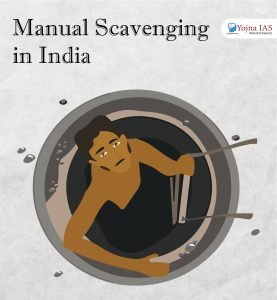23 Oct 2023 Manual Scavenging
This article covers “Daily Current Affairs” and the topic details “Manual Scavenging”. This topic has relevance in the Social Issues section of the UPSC CSE exam.
GS 2: Social Issues
Why in the news?
The Supreme Court has issued a series of directives to both the central and state governments, with the aim of entirely eliminating manual scavenging. Furthermore, the court has called for an increase in compensation in situations of fatality or injury.
Background:
- The court acknowledged the petition filed in 2020, bringing to its attention the pressing issue of fatalities in sewers, despite the practice being legally banned.
- The practice of manual scavenging was prohibited through the enactment of the Employment of Manual Scavengers and Construction of Dry Latrines (Prohibition) Act, 1993, and the Prohibition of Employment as Manual Scavengers and their Rehabilitation Act, 2013.
- The court initiated proceedings against various government entities, including the Ministry of Social Justice and Empowerment, the National Commission for Scheduled Castes, and the National Commission for Scheduled Tribes.
Safai Karamchari Andolan and others vs. Union of India:
- In a landmark case, the Supreme Court reinforced the ban on manual scavenging and issued directives for the rehabilitation of individuals, both traditionally and otherwise, engaged in this hazardous practice. The judgment emphasized that rehabilitation should be founded on principles of justice and transformation.
- The judgment underscored the necessity for rehabilitation that aligns with principles of justice and transformation. Moreover, it emphasized that individuals liberated from manual scavenging should not face unnecessary obstacles in obtaining what is rightfully theirs under the law.
Definition of Manual Scavenging:
- Manual scavenging involves the manual removal of human and animal waste from dry toilets, followed by its transportation and disposal. According to the “Prohibition of Employment as Manual Scavengers and their Rehabilitation Act, 2013 (MS Act, 2013),” it encompasses tasks like manually cleaning, carrying, disposing of, or handling human excreta in insanitary latrines. This practice was officially banned by the anti-manual scavenging Act in 1993 and further reinforced in 2013, making it illegal since December 2013.

Government Initiatives:
- Prohibition of Manual Scavenging:
-
- The Prohibition of Employment as Manual Scavengers and their Rehabilitation Act, 2013, not only prohibits the construction or maintenance of unhygienic toilets but also forbids the employment of individuals in cleaning sewer pipes and swimming pools through hazardous manual methods.
- The Act also outlines measures to rehabilitate individuals identified by municipalities as service providers in this context.
- Constitutional Rights:
-
- Article 21 of the Constitution guarantees the ‘Right to Life’ and ‘Right to Dignity,’ reinforcing the government’s obligation to eradicate the dehumanizing practice of manual scavenging.
- Swachhta Abhiyan App:
-
- The government has developed the Swachhta Abhiyan App to identify and geotag data related to insanitary latrines and manual scavengers. The primary objective is to replace insanitary latrines with sanitary ones and ensure the rehabilitation of manual scavengers, thereby affording them a life of dignity.
The Way Forward
- Accurate Assessment: Nation should conduct comprehensive assessments to accurately determine the number of workers involved in hazardous tasks like cleaning toxic waste.
-
- Empowering Local Authorities: Prioritizing the elimination of manual scavenging under initiatives like the Swachh Bharat Mission and utilizing the available funds for smart cities and urban development can effectively address the issue of manual scavenging.
- Social Sensitization: Addressing the deeply entrenched issue of social stigma and discrimination against manual scavengers is crucial. This requires a concerted effort to raise awareness and understanding about the reasons behind the continued inclusion of manual scavenging in the societal hierarchy.
-
- Stringent Legislation: Enacting and enforcing stringent laws that impose a legal obligation on state organs to provide proper sanitation services can help safeguard the rights of these workers. Such legislation would ensure that their rights are not violated and that they are not subjected to hazardous practices.
Source:https://www.msn.com/en-in/news/other/put-a-total-stop-to-manual-scavenging-supreme-court/ar-AA1iAmxl
Download Yojna daily current affairs eng med 23rd Oct 2023
Q.1 Consider the following statements about Manual scavenging:
- Manual scavenging was officially prohibited by the Prohibition of Employment as Manual Scavengers and their Rehabilitation Act, 1993.
- Swachhta Abhiyan App identifies and geotags data related to insanitary latrines and manual scavengers.
Which of the statements given above is/are correct?
(a) 1 only
(b) 2 only
(c) Both 1 and 2
(d) Neither 1 nor 2
ANSWER: C
Q.2 Discuss the socio-economic and human rights challenges associated with manual scavenging in India, and evaluate the effectiveness of government initiatives and legislation in eradicating this degrading practice.


No Comments